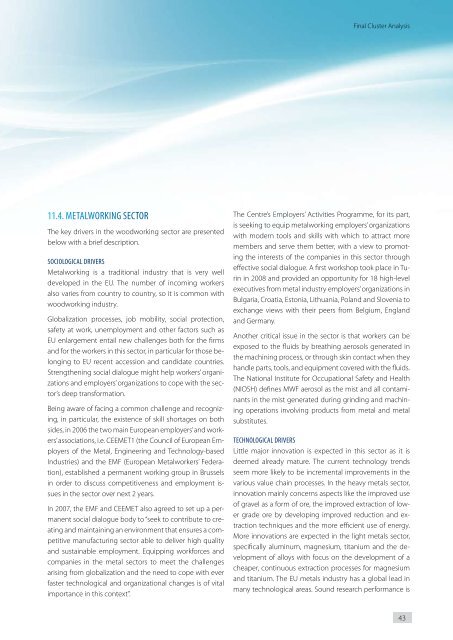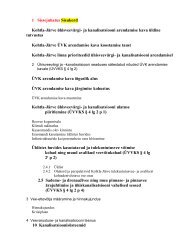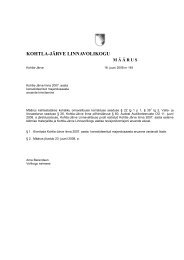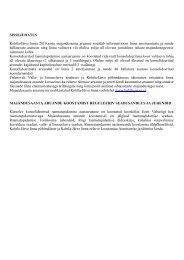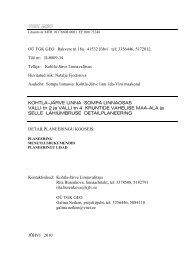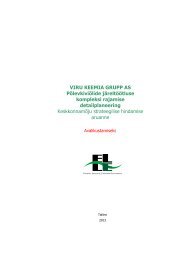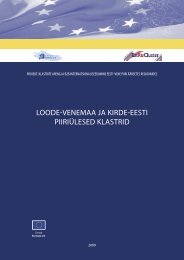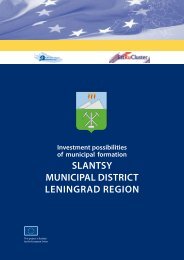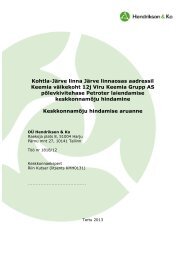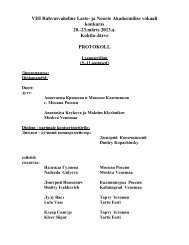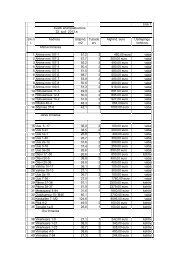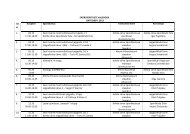FINAL CLUSTER ANALYSIS - Kohtla-Järve
FINAL CLUSTER ANALYSIS - Kohtla-Järve
FINAL CLUSTER ANALYSIS - Kohtla-Järve
Create successful ePaper yourself
Turn your PDF publications into a flip-book with our unique Google optimized e-Paper software.
11.4. metalWorKIng sector<br />
The key drivers in the woodworking sector are presented<br />
below with a brief description.<br />
socIologIcal DrIvers<br />
Metalworking is a traditional industry that is very well<br />
developed in the EU. The number of incoming workers<br />
also varies from country to country, so it is common with<br />
woodworking industry.<br />
Globalization processes, job mobility, social protection,<br />
safety at work, unemployment and other factors such as<br />
EU enlargement entail new challenges both for the fi rms<br />
and for the workers in this sector, in particular for those belonging<br />
to EU recent accession and candidate countries.<br />
Strengthening social dialogue might help workers’ organizations<br />
and employers’ organizations to cope with the sector’s<br />
deep transformation.<br />
Being aware of facing a common challenge and recognizing,<br />
in particular, the existence of skill shortages on both<br />
sides, in 2006 the two main European employers’ and workers’<br />
associations, i.e. CEEMET1 (the Council of European Employers<br />
of the Metal, Engineering and Technology-based<br />
Industries) and the EMF (European Metalworkers’ Federation),<br />
established a permanent working group in Brussels<br />
in order to discuss competitiveness and employment issues<br />
in the sector over next 2 years.<br />
In 2007, the EMF and CEEMET also agreed to set up a permanent<br />
social dialogue body to “seek to contribute to creating<br />
and maintaining an environment that ensures a competitive<br />
manufacturing sector able to deliver high quality<br />
and sustainable employment. Equipping workforces and<br />
companies in the metal sectors to meet the challenges<br />
arising from globalization and the need to cope with ever<br />
faster technological and organizational changes is of vital<br />
importance in this context”.<br />
Final Cluster Analysis<br />
The Centre’s Employers’ Activities Programme, for its part,<br />
is seeking to equip metalworking employers’ organizations<br />
with modern tools and skills with which to attract more<br />
members and serve them better, with a view to promoting<br />
the interests of the companies in this sector through<br />
eff ective social dialogue. A fi rst workshop took place in Turin<br />
in 2008 and provided an opportunity for 18 high-level<br />
executives from metal industry employers’ organizations in<br />
Bulgaria, Croatia, Estonia, Lithuania, Poland and Slovenia to<br />
exchange views with their peers from Belgium, England<br />
and Germany.<br />
Another critical issue in the sector is that workers can be<br />
exposed to the fl uids by breathing aerosols generated in<br />
the machining process, or through skin contact when they<br />
handle parts, tools, and equipment covered with the fl uids.<br />
The National Institute for Occupational Safety and Health<br />
(NIOSH) defi nes MWF aerosol as the mist and all contaminants<br />
in the mist generated during grinding and machining<br />
operations involving products from metal and metal<br />
substitutes.<br />
technologIcal DrIvers<br />
Little major innovation is expected in this sector as it is<br />
deemed already mature. The current technology trends<br />
seem more likely to be incremental improvements in the<br />
various value chain processes. In the heavy metals sector,<br />
innovation mainly concerns aspects like the improved use<br />
of gravel as a form of ore, the improved extraction of lower<br />
grade ore by developing improved reduction and extraction<br />
techniques and the more effi cient use of energy.<br />
More innovations are expected in the light metals sector,<br />
specifi cally aluminum, magnesium, titanium and the development<br />
of alloys with focus on the development of a<br />
cheaper, continuous extraction processes for magnesium<br />
and titanium. The EU metals industry has a global lead in<br />
many technological areas. Sound research performance is<br />
43


